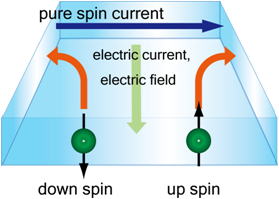The spin Hall effect is an effect of inducing transverse spin current by applying an electric field on the system. This effect is caused by the Berry phase in momentum space, i.e. the nontrivial gauge-field structure in momentum space. Hence it is a manifestation of wave-nature of electrons. In 2003 we predicted that this effect will occur even without impurity scattering, with an example of p-type semiconductors (S.Murakami, N.Nagaosa, S.-C.Zhang, Science 301, 1348(2003)). Together with the similar prediction by Sinova et al., (J. Sinova, D. Culcer, Q. Niu, N. A. Sinitsyn, T. Jungwirth, and A. H. MacDonald, Phys. Rev. Lett. 92, 126603(2004)), this prediction has stimulated experiments on spin Hall effect, and it resulted in a number of experimental observations in various semiconductors and metals.
This effect is scientifically interesting and useful in the sense that it can induce spin current without magnetic field or a magnet. This aspect is useful for applications in spintronics. Up to present, over 600 papers have been published on this issue.

